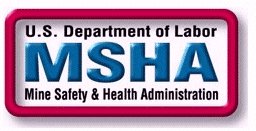 The U.S. Department of Labor’s Mine Safety and Health Administration has fined Star Mine Operations, LLC $1,077,800 following the agency's investigation into the deaths of two miners at Revenue Mine on Nov. 17, 2013. The underground silver ore mine is located in Ouray County, Colorado.
The U.S. Department of Labor’s Mine Safety and Health Administration has fined Star Mine Operations, LLC $1,077,800 following the agency's investigation into the deaths of two miners at Revenue Mine on Nov. 17, 2013. The underground silver ore mine is located in Ouray County, Colorado.
Workers not notified of blast
Around 2 p.m. on the day before the accident occurred, approximately 1,600 pounds of deteriorated explosives were detonated underground in an open air blast. Crew members of the next shift, which reported to work later that evening, were neither notified of the blasting activities on the previous shift, nor was the area where the explosives were set off – called the Monogahela Drift – barricaded to prevent miners from entering.
Two miners on that evening shift became ill while working in that area and retreated from the mine. A third miner also returned to the surface after encountering what he called “bad air.” Despite complaints to mine management from the three miners, no action was taken to identify, correct or report the hazardous condition in the drift. When explosives are detonated, carbon monoxide is released into the atmosphere. It is a toxic gas that can pose a serious risk to workers in an underground mine.
One month of mining experience
The following morning, two members of the day-shift crew traveled into the drift to observe the results of the shots fired on the previous day. One of the miners, Nick Cappanno, who had one month of mining experience, was overcome by toxic levels of carbon monoxide, while the other miner was able to retreat from the area. In an attempt to rescue Mr. Cappanno, the shift boss, Rick Williams, entered the drift and was also overcome by carbon monoxide. Twenty other miners were exposed to carbon monoxide while unsuccessfully attempting to rescue the two victims. Seven of them were hospitalized.
What the company failed to do
MSHA investigators determined that the fatal accident occurred due to management’s failure to dispose of deteriorated explosives in a safe manner. The explosives were detonated in an area of the mine that was not ventilated, and no post-blast examination was conducted. Management also failed to take any action when two miners went into the unventilated Monogahela Drift and reported feeling ill, and it failed to withdraw miners as a result of the imminent danger created by the blast. Management did not establish an accurate and viable ventilation plan, barricade or seal unventilated areas, or properly train new employees on mine health and safety procedures. Finally, MSHA was not immediately notified of the reportable accident involving the two miners falling ill during the evening shift on Nov. 16 when they were exposed to toxic gases caused by the blast in the Monogahela Drift.
Feds detonated damaged explosives
After the accident, approximately 400 pounds of damaged and deteriorated explosives were removed from the mine and safely detonated by the U.S. Department of Justice’s Bureau of Alcohol, Tobacco, Firearms and Explosives and the City of Grand Junction, Colorado’s, Grand Junction Bomb Squad. The remaining explosives were removed from the mine’s underground storage facilities, inventoried, separated by product type and date code, and stored in surface magazines.
As a result of its investigation, MSHA issued eight unwarrantable failure orders, including six designated as flagrant violations. A flagrant violation is defined as “a reckless or repeated failure to make reasonable efforts to eliminate a known violation of a mandatory safety and health standard that substantially and proximately caused, or reasonably could have been expected to cause, death or serious bodily injury.”
A pattern of violations
On Sept. 25, Revenue Mine was put on a pattern of violations of mandatory health or safety standards under Section 104(e) of the Federal Mine Safety and Health Act of 1977. MSHA cited 92 significant and substantial violations at Revenue Mine during the 12-month review period beginning Aug. 1, 2013, and ending July 31, 2014. The agency identified patterns of S&S violations related to roof and rib hazards, handling of explosive materials, ventilation and training practices. Fifty-seven of the citations included either high negligence or reckless disregard by the mine operator. The mine’s S&S issuance rate was 15.67 per 100 inspection hours during the review period, compared to a rate of 4.59 for all other underground metal and nonmetal mines during the same period.


